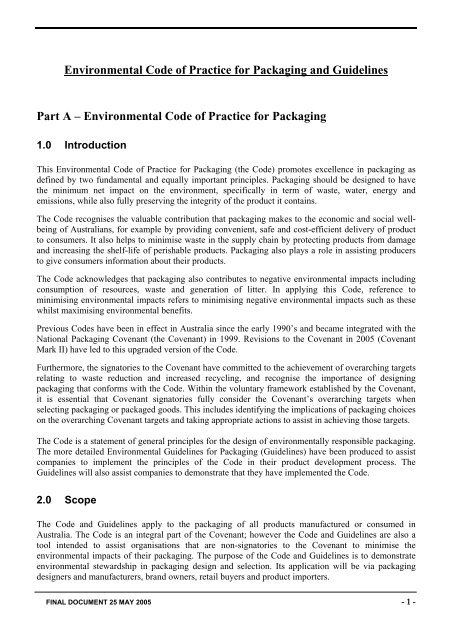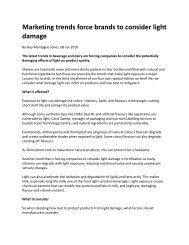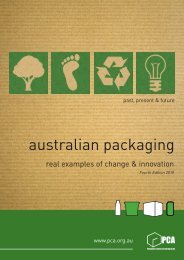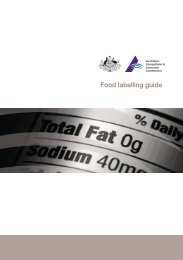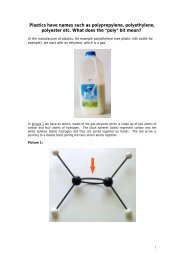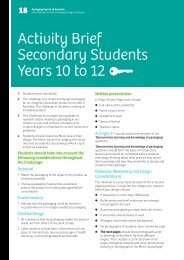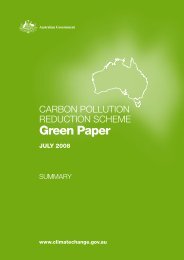Environmental Code of Practice for Packaging - the Packaging ...
Environmental Code of Practice for Packaging - the Packaging ...
Environmental Code of Practice for Packaging - the Packaging ...
Create successful ePaper yourself
Turn your PDF publications into a flip-book with our unique Google optimized e-Paper software.
<strong>Environmental</strong> <strong>Code</strong> <strong>of</strong> <strong>Practice</strong> <strong>for</strong> <strong>Packaging</strong> and GuidelinesPart A – <strong>Environmental</strong> <strong>Code</strong> <strong>of</strong> <strong>Practice</strong> <strong>for</strong> <strong>Packaging</strong>1.0 IntroductionThis <strong>Environmental</strong> <strong>Code</strong> <strong>of</strong> <strong>Practice</strong> <strong>for</strong> <strong>Packaging</strong> (<strong>the</strong> <strong>Code</strong>) promotes excellence in packaging asdefined by two fundamental and equally important principles. <strong>Packaging</strong> should be designed to have<strong>the</strong> minimum net impact on <strong>the</strong> environment, specifically in term <strong>of</strong> waste, water, energy andemissions, while also fully preserving <strong>the</strong> integrity <strong>of</strong> <strong>the</strong> product it contains.The <strong>Code</strong> recognises <strong>the</strong> valuable contribution that packaging makes to <strong>the</strong> economic and social wellbeing<strong>of</strong> Australians, <strong>for</strong> example by providing convenient, safe and cost-efficient delivery <strong>of</strong> productto consumers. It also helps to minimise waste in <strong>the</strong> supply chain by protecting products from damageand increasing <strong>the</strong> shelf-life <strong>of</strong> perishable products. <strong>Packaging</strong> also plays a role in assisting producersto give consumers in<strong>for</strong>mation about <strong>the</strong>ir products.The <strong>Code</strong> acknowledges that packaging also contributes to negative environmental impacts includingconsumption <strong>of</strong> resources, waste and generation <strong>of</strong> litter. In applying this <strong>Code</strong>, reference tominimising environmental impacts refers to minimising negative environmental impacts such as <strong>the</strong>sewhilst maximising environmental benefits.Previous <strong>Code</strong>s have been in effect in Australia since <strong>the</strong> early 1990’s and became integrated with <strong>the</strong>National <strong>Packaging</strong> Covenant (<strong>the</strong> Covenant) in 1999. Revisions to <strong>the</strong> Covenant in 2005 (CovenantMark II) have led to this upgraded version <strong>of</strong> <strong>the</strong> <strong>Code</strong>.Fur<strong>the</strong>rmore, <strong>the</strong> signatories to <strong>the</strong> Covenant have committed to <strong>the</strong> achievement <strong>of</strong> overarching targetsrelating to waste reduction and increased recycling, and recognise <strong>the</strong> importance <strong>of</strong> designingpackaging that con<strong>for</strong>ms with <strong>the</strong> <strong>Code</strong>. Within <strong>the</strong> voluntary framework established by <strong>the</strong> Covenant,it is essential that Covenant signatories fully consider <strong>the</strong> Covenant’s overarching targets whenselecting packaging or packaged goods. This includes identifying <strong>the</strong> implications <strong>of</strong> packaging choiceson <strong>the</strong> overarching Covenant targets and taking appropriate actions to assist in achieving those targets.The <strong>Code</strong> is a statement <strong>of</strong> general principles <strong>for</strong> <strong>the</strong> design <strong>of</strong> environmentally responsible packaging.The more detailed <strong>Environmental</strong> Guidelines <strong>for</strong> <strong>Packaging</strong> (Guidelines) have been produced to assistcompanies to implement <strong>the</strong> principles <strong>of</strong> <strong>the</strong> <strong>Code</strong> in <strong>the</strong>ir product development process. TheGuidelines will also assist companies to demonstrate that <strong>the</strong>y have implemented <strong>the</strong> <strong>Code</strong>.2.0 ScopeThe <strong>Code</strong> and Guidelines apply to <strong>the</strong> packaging <strong>of</strong> all products manufactured or consumed inAustralia. The <strong>Code</strong> is an integral part <strong>of</strong> <strong>the</strong> Covenant; however <strong>the</strong> <strong>Code</strong> and Guidelines are also atool intended to assist organisations that are non-signatories to <strong>the</strong> Covenant to minimise <strong>the</strong>environmental impacts <strong>of</strong> <strong>the</strong>ir packaging. The purpose <strong>of</strong> <strong>the</strong> <strong>Code</strong> and Guidelines is to demonstrateenvironmental stewardship in packaging design and selection. Its application will be via packagingdesigners and manufacturers, brand owners, retail buyers and product importers.FINAL DOCUMENT 25 MAY 2005 - 1 -
Existing and future relevant standards and legislation maintain <strong>the</strong>ir jurisdiction and status and shouldbe adhered to in conjunction with <strong>the</strong> <strong>Code</strong> and Guidelines.3.0 ObjectivesThe <strong>Code</strong> and Guidelines are intended to guide <strong>the</strong> packaging supply and recovery chains inminimising overall life cycle environmental impacts <strong>of</strong> packaging and packaged products, andachieving <strong>the</strong> overarching targets as set out in <strong>the</strong> Covenant. Accordingly, <strong>the</strong> objectives <strong>of</strong> <strong>the</strong> <strong>Code</strong>and Guidelines are to:1. Protect and deliver goods efficiently with <strong>the</strong> minimum environmental impact.2. Use resources (including materials and energy) more efficiently.3. Reduce <strong>the</strong> amount <strong>of</strong> waste and litter generated by packaging through facilitating reuse orrecycling.4. Minimise negative impacts <strong>of</strong> packaging and packaged products on humans and <strong>the</strong> naturalenvironment.5. Ensure effective and clearly documented practices are in place to address environmentalconcerns in <strong>the</strong> product development and review process <strong>for</strong> packaging and packaged products.More broadly, <strong>the</strong> <strong>Code</strong> and Guidelines should be seen as tools <strong>for</strong> <strong>the</strong> design and manufacture <strong>of</strong>innovative packaging that meets <strong>the</strong> sometimes conflicting demands <strong>of</strong> <strong>the</strong> market, consumer protectionand <strong>the</strong> environment.4.0 Definitions[It was agreed in <strong>the</strong> 23 March 2005 Task Force meeting that <strong>the</strong> definitions would have to be agreedon once <strong>the</strong> final Covenant package (including <strong>the</strong> NEPM) was completed and that definitions wouldneed to be consistent across both <strong>the</strong> <strong>Code</strong> and Covenant documents.]CEN” means <strong>the</strong> European Committee <strong>for</strong> Standardisation.“<strong>Code</strong>” means <strong>the</strong> <strong>Environmental</strong> <strong>Code</strong> <strong>of</strong> <strong>Practice</strong> <strong>for</strong> <strong>Packaging</strong>.“consumer packaging” means all packaging products made <strong>of</strong> any material, or combination <strong>of</strong>materials, <strong>for</strong> <strong>the</strong> containment, protection, marketing or handling <strong>of</strong> retail consumer products. This alsoincludes distribution packaging.“Covenant” means <strong>the</strong> National <strong>Packaging</strong> Covenant.“degradable” means a characteristic <strong>of</strong> a product or packaging that, with respect to specific conditions,allows it to break down to a specific extent within a given time.“distribution packaging” means packaging that contains multiples <strong>of</strong> products (<strong>the</strong> same or mixed)intended <strong>for</strong> consumer use, including:Secondary: packaging used to secure or unitise multiples <strong>of</strong> consumer packaging, eg. cardboard box,shipper, shrinkfilm overwrap.Tertiary: packaging used to secure or unitise multiples <strong>of</strong> secondary packaging, e.g. pallet wrappingstretchfilm, shrinkfilm, strapping.FINAL DOCUMENT 25 MAY 2005 - 2 -
“downcycling” means reprocessing <strong>of</strong> a material into a lower value product, <strong>for</strong> example packagingglass used <strong>for</strong> road base, or paper used as a filler in plastic lumber.“environmental claim” means a statement, symbol or graphic that indicates an environmental aspect<strong>of</strong> a product, a component or packaging.“environmental impact” means any change to <strong>the</strong> environment, whe<strong>the</strong>r adverse or beneficial, whollyor partially resulting from an organisation’s activities or products.“Guidelines” means <strong>the</strong> <strong>Environmental</strong> Guidelines <strong>for</strong> <strong>Packaging</strong> associated with <strong>the</strong> <strong>Code</strong>.“industry” means any manufacturing, industrial, commercial, wholesale or retail activity or process,that can result in <strong>the</strong> generation, recycling, treatment, transport, storage or disposal <strong>of</strong> consumerpackaging.“key per<strong>for</strong>mance indicators” means <strong>the</strong> agreed, quantifiable measurements that reflect <strong>the</strong> criticalsuccess factors <strong>of</strong> <strong>the</strong> National <strong>Packaging</strong> Covenant.“landfill” means waste disposal sites used <strong>for</strong> <strong>the</strong> authorised deposit <strong>of</strong> solid waste onto or into land.“life cycle” means consecutive and interlinked stages <strong>of</strong> a product system, from raw materialacquisition or generation <strong>of</strong> natural resources to final disposal.“litter” means consumer packaging that when removed from a product is intentionally orunintentionally discarded to <strong>the</strong> environment.“NPCC” means <strong>the</strong> National <strong>Packaging</strong> Covenant Council“NPCIA” means <strong>the</strong> National <strong>Packaging</strong> Covenant Industry Association.“PACIA” means <strong>the</strong> Plastics and Chemical Industry Association.“packaging recovery chain” refers to <strong>the</strong> companies and/or organisations who provide recyclatecollection services, reprocessors, secondary markets and users <strong>of</strong> recovered, post-consumer and postindustrialpackaging materials and paper products.“packaging supply chain” means each <strong>of</strong> <strong>the</strong> organisations that participate in <strong>the</strong> creation, distributionand sale <strong>of</strong> consumer packaging and / or products. These include but are not limited to:• suppliers <strong>of</strong> raw materials <strong>for</strong> consumer packaging• manufacturers <strong>of</strong> consumer packaging• suppliers / distributors <strong>of</strong> consumer packaging• manufacturers <strong>of</strong> consumer products• fillers <strong>of</strong> consumer packaging, eg contract packers• brand owners <strong>of</strong> consumer products• wholesalers / distributors <strong>of</strong> consumer products• retailers <strong>of</strong> consumer products“post-consumer recycled content” means material generated by households or by commercial,industrial and institutional facilities in <strong>the</strong>ir role as end-users <strong>of</strong> <strong>the</strong> product which can no longer beused <strong>for</strong> its intended purpose. This includes returns <strong>of</strong> material from <strong>the</strong> distribution chain.FINAL DOCUMENT 25 MAY 2005 - 3 -
“pre-consumer recycled content” means material diverted from <strong>the</strong> waste stream during amanufacturing process. Excluded is reutilisation <strong>of</strong> materials such as rework, regrind or scrap generatedin a process and capable <strong>of</strong> being reclaimed within <strong>the</strong> same process that generated it.“recovery” means <strong>the</strong> system whereby materials are diverted from <strong>the</strong> waste stream <strong>for</strong> reuse orreprocessing <strong>for</strong> use as a raw material <strong>for</strong> <strong>the</strong> manufacture <strong>of</strong> a new product.“recyclable” packaging means reasonably able to be recovered in Australia through collection or drop<strong>of</strong>fsystems and able to be reprocessed and used as a raw material <strong>for</strong> <strong>the</strong> manufacture <strong>of</strong> a newproduct.“recycle” means recover <strong>the</strong> consumer packaging and use it as a raw material to produce ano<strong>the</strong>rproduct.“recycled content” is <strong>the</strong> percentage by weight or volume <strong>of</strong> pre-consumer and/or post-consumerrecycled material in <strong>the</strong> raw materials used <strong>for</strong> <strong>the</strong> manufacture <strong>of</strong> a product.“reuse” means <strong>the</strong> use <strong>of</strong> consumer packaging (including distribution packaging) <strong>for</strong> <strong>the</strong> same orsimilar purpose as <strong>the</strong> original purpose without subjecting <strong>the</strong> packaging to a manufacturing processthat would change its physical appearance.“signatory” means a signatory to <strong>the</strong> National <strong>Packaging</strong> Covenant, and includes an organisation thataccedes to <strong>the</strong> Covenant after it is made, whe<strong>the</strong>r be<strong>for</strong>e or after <strong>the</strong> commencement <strong>of</strong> <strong>the</strong> supportingregulation.“toxic substance” means a substance which is poisonous or harmful to <strong>the</strong> health <strong>of</strong> living organisms.“waste” means material not being recovered <strong>for</strong> reuse and entering <strong>the</strong> waste stream, includingdischarges to air and water as well as solid waste from manufacturing or treatment processes.“waste hierarchy” is a concept that provides a framework <strong>of</strong> environmental decision making ondesirable waste management options - prioritising first <strong>the</strong> reduction <strong>of</strong> material use, second <strong>the</strong> reuse<strong>of</strong> product, third <strong>the</strong> recycling <strong>of</strong> <strong>the</strong> material and lastly <strong>the</strong> optimisation <strong>of</strong> its final disposal.5.0 <strong>Packaging</strong> Design and SelectionThe vital role packaging plays in modern society is widely recognised <strong>for</strong> ensuring that products areprotected and preserved, waste minimised, and quality, health and safety assured. Key roles <strong>of</strong>packaging include:• Consumer safety and in<strong>for</strong>mation• Product shelf life, integrity and safety• Logistical and supply chain considerations• Theft prevention• Marketing and sales<strong>Packaging</strong> is subject to o<strong>the</strong>r codes, standards and legislation. Users <strong>of</strong> <strong>the</strong> <strong>Code</strong> and Guidelines shouldensure that <strong>the</strong>ir packaging con<strong>for</strong>ms with all government Acts and Regulations and relevant AustralianStandards.FINAL DOCUMENT 25 MAY 2005 - 4 -
Users <strong>of</strong> <strong>the</strong> <strong>Code</strong> and Guidelines must fully consider <strong>the</strong> positive (beneficial) and negative (adverse)environmental impacts <strong>of</strong> packaging in <strong>the</strong>ir decision making process and document this decisionmaking process. The User <strong>of</strong> <strong>the</strong> <strong>Code</strong> and Guidelines should consider <strong>the</strong> overarching targets <strong>for</strong>reductions in packaging to landfill and increased packaging recycling under <strong>the</strong> Covenant. While it isnot a requirement <strong>of</strong> <strong>the</strong> <strong>Code</strong> and Guidelines that individual products support <strong>the</strong> achievement <strong>of</strong> <strong>the</strong>seoverarching targets, it is important that Users <strong>of</strong> <strong>the</strong> <strong>Code</strong> and Guidelines understand <strong>the</strong> threat <strong>of</strong>prescriptive regulation if <strong>the</strong>se overarching targets are not met. The overall strategies to addressenvironmental impacts <strong>of</strong> packaging and packaged products that must be considered across <strong>the</strong>packaging supply and recovery chains include:• Source reduction;• Potential <strong>for</strong> packaging reuse;• Recovery and recycling;• Ability to incorporate recycled content;• Minimising impacts <strong>of</strong> packaging;• Propensity to become litter; and• Consumer in<strong>for</strong>mation.Where conflicting objectives exist, signatories should take steps to ensure that <strong>the</strong>y have chosen <strong>the</strong>approach that best optimises <strong>the</strong> beneficial and minimises <strong>the</strong> adverse environmental impacts across <strong>the</strong>packaging supply and recovery chains without diminishing <strong>the</strong> package’s ability to per<strong>for</strong>m its primaryfunction(s). The decision making process used in each <strong>of</strong> <strong>the</strong> strategies mentioned below, at aminimum, must be documented and demonstrated by Users <strong>of</strong> <strong>the</strong> <strong>Code</strong> and Guidelines.5.1 Source Reduction<strong>Packaging</strong> should be manufactured so that <strong>the</strong> packaging materials are optimised to ensure <strong>the</strong>minimum amount required to maintain <strong>the</strong> necessary level <strong>of</strong> safety, hygiene and acceptability <strong>of</strong> <strong>the</strong>packaged product to <strong>the</strong> User <strong>of</strong> <strong>the</strong> <strong>Code</strong> and Guidelines and/or consumer.Consumption <strong>of</strong> o<strong>the</strong>r resources such as energy should also be minimised across <strong>the</strong> packaging supplyand recovery chains, <strong>for</strong> example packaging decision making should consider how <strong>the</strong> product andpackaging are to be distributed and whe<strong>the</strong>r distribution requires special conditions such asrefrigeration. The design <strong>of</strong> <strong>the</strong> product/packaging system should optimise transport efficiency (and<strong>the</strong>re<strong>for</strong>e fuel consumption), <strong>for</strong> example by maximising <strong>the</strong> amount <strong>of</strong> product transported in a truckor container.Refer to Section 10 <strong>of</strong> <strong>the</strong> Guidelines.5.2 Potential <strong>for</strong> Reuse<strong>Packaging</strong> should be designed and produced in such a way as to maximise its potential <strong>for</strong> reuse where<strong>the</strong> environmental benefit can be demonstrated. Priority should be given to reuse <strong>for</strong> <strong>the</strong> sameapplication (<strong>for</strong> example pool pallet system <strong>for</strong> distribution) followed by reuse <strong>for</strong> an alternativeapplication (<strong>for</strong> example glass jars used as drinking vessels).Refer to Section 11 <strong>of</strong> <strong>the</strong> Guidelines.FINAL DOCUMENT 25 MAY 2005 - 5 -
5.3 Recovery and Recycling<strong>Packaging</strong> should be designed and produced in such a way as to maximise its potential <strong>for</strong> recovery andrecycling at end-<strong>of</strong>-life and to minimise <strong>the</strong> environmental impacts <strong>of</strong> its disposal.The packaging design should support recovery in accordance with <strong>the</strong> waste hierarchy, with preferencegiven to recycling <strong>for</strong> <strong>the</strong> same or similar application (‘closed loop’) followed by recycling <strong>for</strong> analternative application (‘downcycling’ or composting).Where possible, <strong>the</strong> package should consist <strong>of</strong> a single material, or materials, which can be readilyseparated and sorted <strong>for</strong> recovery. <strong>Packaging</strong> should be designed to minimise <strong>the</strong> impacts that anycomponents such as closures, labels, sleeves, carry handles, etc may have on <strong>the</strong> recovery process. Thisrequires consultation with companies involved in collection, sorting and reprocessing <strong>of</strong> <strong>the</strong> packaging.<strong>Packaging</strong> (including imported packaging and packaged goods) must not be introduced into <strong>the</strong> marketwithout full consideration <strong>of</strong> <strong>the</strong> impacts on resource recovery and recycling, <strong>for</strong> example degradableplastics packaging. However users <strong>of</strong> <strong>the</strong> <strong>Code</strong> and Guidelines should recognise that innovation leadingto improvements in long term environmental outcomes should also be encouraged and consideredwhere appropriate (even if <strong>the</strong>re are short term or transitional difficulties).Refer to Section 12 <strong>of</strong> <strong>the</strong> Guidelines and to <strong>the</strong> Recycling Materials Manual available from <strong>the</strong>Australian Council <strong>of</strong> Recyclers.5.4 Ability to Incorporate Recycled Content<strong>Packaging</strong> should maximise <strong>the</strong> use <strong>of</strong> recycled content where use <strong>of</strong> such content is physicallypossible, not detrimental to <strong>the</strong> function <strong>of</strong> <strong>the</strong> packaging or <strong>the</strong> packaged product, and would notviolate applicable health and safety standards.Priority should be given to incorporating post-consumer recycled material to support markets <strong>for</strong>material collected from recovery systems. Where appropriate, post-industrial recycled material shouldalso be incorporated and considered.In accordance with AS/NZS ISO14021, where a claim <strong>of</strong> recycled content is made, <strong>the</strong> percentage <strong>of</strong>pre-consumer or post-consumer recycled material shall be stated.Refer to Section 13 <strong>of</strong> <strong>the</strong> Guidelines.5.5 Minimising Impacts <strong>of</strong> <strong>Packaging</strong>Users <strong>of</strong> <strong>the</strong> <strong>Code</strong> and Guidelines should consider <strong>the</strong>ir common law liabilities in relation to <strong>the</strong> use <strong>of</strong>hazardous or toxic materials, assess <strong>the</strong> packaging <strong>for</strong> <strong>the</strong> presence <strong>of</strong> toxic substances that are likely topose risk and endeavour to reduce that risk accordingly.Refer to Section 14 <strong>of</strong> <strong>the</strong> Guidelines.FINAL DOCUMENT 25 MAY 2005 - 6 -
5.6 Propensity to Become LitterUsers <strong>of</strong> <strong>the</strong> <strong>Code</strong> and Guidelines must be aware <strong>of</strong> whe<strong>the</strong>r or not <strong>the</strong>ir packaging is typically found inlitter streams. If <strong>the</strong>ir packaging is typically found in <strong>the</strong> litter stream <strong>the</strong>n companies should takespecific measures to reduce <strong>the</strong> impact <strong>of</strong> such litter through, <strong>for</strong> example:• Design to minimise <strong>the</strong> number <strong>of</strong> separable components; and• Accurate consumer in<strong>for</strong>mation to encourage appropriate management.Refer to Section 15 <strong>of</strong> <strong>the</strong> Guidelines.5.7 Consumer In<strong>for</strong>mationIf environmental claims are being made about such things as recycled content <strong>of</strong> packaging,recyclability or degradability, <strong>the</strong>n this should be made clear to consumers <strong>of</strong> <strong>the</strong> packaging orpackaged product where possible through <strong>the</strong> use <strong>of</strong> environmental labelling. Users <strong>of</strong> <strong>the</strong> <strong>Code</strong> andGuidelines seeking to adopt environmental labelling on packaging must refer to AS/NZS ISO14021:2000. This states that environmental labels and declarations should aim to encourage demand <strong>for</strong>and supply <strong>of</strong> products that cause less stress on <strong>the</strong> environment, through communication <strong>of</strong> verifiable,accurate in<strong>for</strong>mation on environmental aspects <strong>of</strong> products that is not misleading.Failure to properly adhere to labelling guidelines may raise issues <strong>of</strong> Trade <strong>Practice</strong> law.• The mobius loop should be used to make environmental claims when supported properly inaccordance with AS/NZS 14021:2000.• In contrast <strong>the</strong> Plastics Identification <strong>Code</strong> is a voluntary system <strong>of</strong> marking plasticcontainers to identify <strong>the</strong> plastic resin from which <strong>the</strong>y are made and it should be usedwhere appropriate and possible. It is not intended to be a guarantee <strong>of</strong> recycling ability or toprovide companies with a plat<strong>for</strong>m <strong>for</strong> environmental claims.Refer to Section 16 <strong>of</strong> <strong>the</strong> Guidelines.6.0 ImplementationImplementation <strong>of</strong> <strong>the</strong> <strong>Code</strong> and Guidelines has a <strong>for</strong>mal meaning. A User <strong>of</strong> <strong>the</strong> <strong>Code</strong> and Guidelinesis said to have implemented <strong>the</strong>m if <strong>the</strong> following is true:• The User has considered <strong>the</strong> seven strategies <strong>for</strong> reducing <strong>the</strong> environmental impact <strong>of</strong>packaging and packaged products while developing or selecting any new packaging orreviewing existing packaging;• The User has documented that each <strong>of</strong> <strong>the</strong> seven strategies was considered (ei<strong>the</strong>r inaccepting or rejecting) in respect <strong>of</strong> an item <strong>of</strong> packaging; and• The User has sought to utilise its influence on supply chain linkages to improve <strong>the</strong> uptake<strong>of</strong> <strong>the</strong> <strong>Code</strong> and Guidelines.In accordance with <strong>the</strong> Guidelines, documentation in accordance with European Committee <strong>for</strong>Standardisation (CEN) Umbrella Standard EN 13427:2004 <strong>Packaging</strong> – Requirements <strong>for</strong> <strong>the</strong> use <strong>of</strong>European Standards in <strong>the</strong> field <strong>of</strong> packaging and packaging waste and its associated EuropeanStandards may be used in lieu <strong>of</strong> detailed documentation <strong>for</strong> applicable strategies. Strategies <strong>for</strong> litterand consumer in<strong>for</strong>mation are not covered under <strong>the</strong> European Standards documentation provisions.FINAL DOCUMENT 25 MAY 2005 - 7 -
6.1 Users <strong>of</strong> <strong>the</strong> <strong>Code</strong> and Guidelines that are Covenant signatoriesAlthough <strong>the</strong> <strong>Code</strong> (and Guidelines) serves as a stand-alone document to assist industry in usingpackaging in an environmentally sound manner, it is also a specific component <strong>of</strong> <strong>the</strong> Covenant(Schedule 4). For <strong>the</strong> benefit <strong>of</strong> Users <strong>of</strong> <strong>the</strong> <strong>Code</strong> and Guidelines that are signatories to <strong>the</strong> Covenant,this section describes that interaction.The Covenant is designed to minimise <strong>the</strong> environmental impacts along <strong>the</strong> packaging supply chainarising from <strong>the</strong> use <strong>of</strong> packaging including: its specification and design; conservation <strong>of</strong> resourcesduring its manufacture and filling; and facilitation <strong>of</strong> <strong>the</strong> reuse and recycling <strong>of</strong> used packagingmaterials.The Covenant establishes a framework <strong>for</strong> <strong>the</strong> effective life cycle management <strong>of</strong> consumer packagingand paper to be delivered through a collaborative approach between all sectors <strong>of</strong> <strong>the</strong> packaging supplychain, consumers, collectors, reprocessors and Government. The Guidelines function as an operationaltool to help industry achieve Covenant objectives.The revised Covenant Mark II includes specific Key Per<strong>for</strong>mance Indicators (KPIs) <strong>for</strong> Covenantsignatories. A number <strong>of</strong> <strong>the</strong>se KPIs are directly linked to <strong>the</strong> <strong>Code</strong> and Guidelines, as shown in Table1.Table 1: Covenant KPIs Linked to Implementation <strong>of</strong> <strong>the</strong> <strong>Code</strong> and GuidelinesKey Per<strong>for</strong>mance Indicator [re-examine if KPIs are modified under Covenant discussions]1.1 Total weight <strong>of</strong> packaging (including distribution packaging) used p.a. (domestic & imported) and <strong>the</strong> total weight <strong>of</strong>products packaged1.2 Resources used to produce <strong>the</strong> package: energy used, water used and production efficiency1.3 Changes to protection, safety, hygiene and shelf-life considerations associated with <strong>the</strong> packaging1.4 Changes in marketing and distribution <strong>of</strong> <strong>the</strong> product to minimise packaging2.1 Proportion <strong>of</strong> recycled content used p.a. in packaging, by material type (including plastic bags)3.1 Reduction in new and existing product packaging unable to be recovered and re-utilised using existing recoveryschemes4.1 Total weight <strong>of</strong> packaging material re-utilised by type and end market4.4 Products purchased with recycled content (number <strong>of</strong> units purchased as a percentage <strong>of</strong> total units <strong>for</strong> <strong>the</strong> 3 highestquantity purchases)6.1 Number <strong>of</strong> signatories who have <strong>for</strong>mally adopted <strong>the</strong> <strong>Environmental</strong> <strong>Code</strong> <strong>of</strong> <strong>Practice</strong> <strong>for</strong> <strong>Packaging</strong> (<strong>Code</strong>) anddeveloped systems <strong>for</strong> implementation8.4 Weight <strong>of</strong> packaging to landfill and recycling from in-house operations9.3 Improvements in knowledge about <strong>the</strong> functional attributes <strong>of</strong> packaging, including recyclability/ reuse9.4 Increase in consumer in<strong>for</strong>mation to enable more in<strong>for</strong>med behaviourAdoption and implementation <strong>of</strong> <strong>the</strong> <strong>Code</strong> and Guidelines, as well as progress against KPIs, is to beaddressed and documented through <strong>the</strong> Covenant’s Action Planning process embodied in Schedule 3 <strong>of</strong><strong>the</strong> Covenant.All Covenant signatories are required to submit an Action Plan detailing how <strong>the</strong>y plan to demonstrateand report on <strong>the</strong>ir Covenant actions and commitments including <strong>the</strong> incorporation <strong>of</strong> <strong>the</strong> principlesidentified in <strong>the</strong> <strong>Code</strong> and <strong>the</strong> processes set out in <strong>the</strong> Guidelines. Action Plans will be assessed <strong>for</strong>validity and content in accordance with Schedule 3 <strong>of</strong> <strong>the</strong> Covenant.FINAL DOCUMENT 25 MAY 2005 - 8 -
The Guidelines provide practical measures <strong>for</strong> ensuring that Action Plans reflect <strong>for</strong>mal <strong>Code</strong> adoptionand implementation. In addition <strong>the</strong>y also provide a method through which its implementation candemonstrate a signatory’s level <strong>of</strong> commitment to achieving environmental improvement.Users <strong>of</strong> <strong>the</strong> <strong>Code</strong> and Guidelines must be able to demonstrate and document how <strong>the</strong>ir total packagingdecision making will contribute to <strong>the</strong> overarching waste reduction and recovery targets set out in <strong>the</strong>Covenant. Key overarching targets, as identified in <strong>the</strong> Covenant, which all signatories must addressare:• a reduction in total amounts <strong>of</strong> packaging disposed <strong>of</strong> to landfill;• an increase in <strong>the</strong> amount <strong>of</strong> packaging recycled;• increased use <strong>of</strong> recycled packaging materials in new products;• reductions in <strong>the</strong> use <strong>of</strong> non-recyclable packaging; and• improved company per<strong>for</strong>mance against baseline data.6.2 General <strong>Code</strong> Management/GovernanceWhilst <strong>the</strong> <strong>Code</strong> and Guidelines are strongly linked with <strong>the</strong> Covenant, <strong>the</strong>y remain an industry code <strong>of</strong>practice and ownership <strong>the</strong>re<strong>for</strong>e remains with industry. The operation and review <strong>of</strong> <strong>the</strong> <strong>Code</strong> andGuidelines is administered by a Management Committee consisting <strong>of</strong> representatives <strong>of</strong>:• Australian Council <strong>of</strong> Recyclers• Australian Food and Grocery Council• Australian Industry Group• Australian Retailers Association• Beverage Industry Environment Council• <strong>Packaging</strong> Council <strong>of</strong> Australia• Plastics and Chemicals Industries Association.The Management Committee’s terms <strong>of</strong> reference are:• to regularly review <strong>the</strong> <strong>Code</strong> and Guidelines in <strong>the</strong> light <strong>of</strong> changing technological, social,economic and environmental considerations at least every three years;• to ensure timely and accessible updating <strong>of</strong> relevant references and guidelines;• provide guidance on, and make recommendations <strong>for</strong>, <strong>the</strong> resolution <strong>of</strong> any matters thatcome be<strong>for</strong>e it;• promote <strong>the</strong> <strong>Code</strong> and Guidelines to industry, educators and <strong>the</strong> community;• to ensure con<strong>for</strong>mance with <strong>the</strong> <strong>Code</strong> and Guidelines by industry Users that are notCovenant signatories (compliance with <strong>the</strong> <strong>Code</strong> is mandatory <strong>for</strong> signatories); and• establish any subcommittees, o<strong>the</strong>r advisory bodies or administrative structures necessary toensure and promote <strong>the</strong> effectiveness <strong>of</strong> <strong>the</strong> <strong>Code</strong> and Guidelines.The Management Committee will establish a "Complaints Log" to record and track all complaintsreceived and be responsible <strong>for</strong> <strong>the</strong> day-to-day management <strong>of</strong> <strong>the</strong> "complaints system". Complaintswill first be considered and addressed by <strong>the</strong> Management Committee on a case by case basis todetermine validity and <strong>the</strong> relevance <strong>of</strong> <strong>the</strong> complaint to <strong>the</strong> <strong>Code</strong>. Similar complaints against particularclasses <strong>of</strong> packaging may be aggregated as appropriate.FINAL DOCUMENT 25 MAY 2005 - 9 -
Upon receipt <strong>of</strong> a valid complaint, <strong>the</strong> Management Committee will call <strong>for</strong> input from both <strong>the</strong>complainant and <strong>the</strong> company alleged to have failed to comply with <strong>the</strong> <strong>Code</strong> and Guidelines.Responses to <strong>the</strong> calls <strong>for</strong> in<strong>for</strong>mation should be met by both <strong>the</strong> complainant and <strong>the</strong> alleged <strong>of</strong>fendingcompany in writing within thirty (30) days from <strong>the</strong> receipt <strong>of</strong> <strong>the</strong> request.Where said complaint is determined by <strong>the</strong> Management Committee to have objective and soundclaims and refers to <strong>the</strong> packaging or packaged product <strong>of</strong> a Covenant signatory, <strong>the</strong> ManagementCommittee will ensure that said complaint is <strong>for</strong>warded to <strong>the</strong> National <strong>Packaging</strong> Covenant Council(NPCC) to undertake <strong>the</strong>ir own investigations to determine whe<strong>the</strong>r <strong>the</strong> complaint is contrary to ei<strong>the</strong>r<strong>the</strong> Covenant or <strong>the</strong> signatories’ Action Plans. Determinations <strong>of</strong> con<strong>for</strong>mance or non-con<strong>for</strong>mancewith <strong>the</strong> <strong>Code</strong> and Guidelines will be reported to <strong>the</strong> NPCC within seven (7) days <strong>of</strong> suchdetermination being made by <strong>the</strong> Management Committee. It is NOT expected that <strong>the</strong> ManagementCommittee will play any role in determining <strong>the</strong> level <strong>of</strong> corrective action required or penaltiesnecessary.Should a complaint concern a company represented on <strong>the</strong> Management Committee <strong>the</strong>n thatrepresentative shall, <strong>for</strong> that investigation, disqualify himself or herself and <strong>the</strong> Chair <strong>of</strong> <strong>the</strong>Management Committee may appoint a substitute to act as a representative on <strong>the</strong> ManagementCommittee.At <strong>the</strong> request <strong>of</strong> <strong>the</strong> Management Committee <strong>the</strong> User subject to a complaint shall produce allsupporting materials and evidence justifying <strong>the</strong> company's claim to meeting <strong>the</strong> <strong>Code</strong> and Guidelines.The Management Committee shall have <strong>the</strong> authority to co-opt <strong>the</strong> services <strong>of</strong> appropriate experts asrequired. Such co-opted experts shall have no voting rights. The costs incurred in <strong>the</strong> co-opting <strong>of</strong>appropriate experts shall be covered by <strong>the</strong> parties to <strong>the</strong> complaint on a basis predetermined by <strong>the</strong>Management Committee and agreed in writing by <strong>the</strong> parties prior to <strong>the</strong> co-opting <strong>of</strong> such services.The Management Committee will report outcomes <strong>of</strong> its investigations and results in a transparentmanner regardless <strong>of</strong> whe<strong>the</strong>r <strong>the</strong> complaint refers to a signatory and non signatory.7.0 CommunicationThe communication <strong>of</strong> this <strong>Code</strong> and Guidelines and <strong>the</strong>ir requirements are to be communicated to allUsers <strong>of</strong> <strong>the</strong> <strong>Code</strong> and Guidelines through a range <strong>of</strong> channels. The National <strong>Packaging</strong> CovenantIndustry Association (NPCIA) and its representative bodies will be responsible <strong>for</strong> ensuring that allsignatories are aware <strong>of</strong> <strong>the</strong> <strong>Code</strong> and Guidelines. Respective industry organisations are to ensuresector companies have access to <strong>the</strong> <strong>Code</strong> and Guidelines and <strong>the</strong>ir implementation. Jurisdictions at <strong>the</strong>state and federal level will also be responsible <strong>for</strong> <strong>the</strong> communication <strong>of</strong> <strong>the</strong> <strong>Code</strong> and Guidelines tonon-signatories <strong>of</strong> <strong>the</strong> Covenant.FINAL DOCUMENT 25 MAY 2005 - 10 -
8.0 NotesDevelopment <strong>of</strong> <strong>the</strong> <strong>Code</strong> and Guidelines has drawn from a range <strong>of</strong> sources with <strong>the</strong> aim <strong>of</strong> achievinggood practice including <strong>the</strong> relevant CEN standards, New Zealand <strong>Code</strong> 1 , UK <strong>Code</strong> 2 and stakeholderconsultations. Where appropriate, relevant <strong>Code</strong> and Guidelines definitions have been adopted in <strong>the</strong>irentirety from <strong>the</strong> Covenant to help ensure consistency. The contributions <strong>of</strong> all <strong>the</strong>se sources are greatlyappreciated.“<strong>Packaging</strong> supply and recovery chain” is intended to encompass <strong>the</strong> separate definitions <strong>of</strong> “packagingsupply chain” and “packaging recovery chain”.1 <strong>Packaging</strong> Council <strong>of</strong> New Zealand <strong>Code</strong> <strong>of</strong> <strong>Practice</strong> <strong>for</strong> <strong>the</strong> <strong>Packaging</strong> <strong>of</strong> Consumer Goods.2 Incpen <strong>Code</strong> <strong>of</strong> <strong>Practice</strong> <strong>for</strong> Optimising <strong>Packaging</strong> and Minimising Waste.FINAL DOCUMENT 25 MAY 2005 - 11 -
PART B - <strong>Environmental</strong> Guidelines <strong>for</strong> <strong>Packaging</strong>Users <strong>of</strong> <strong>the</strong> <strong>Code</strong> and Guidelines must implement <strong>the</strong> principles <strong>of</strong> <strong>the</strong> <strong>Code</strong> in <strong>the</strong>ir productdevelopment and review process and demonstrate that <strong>the</strong>y have implemented <strong>the</strong> <strong>Code</strong> and Guidelinesin accordance with Section 6.The following sections provide guidance to Users <strong>of</strong> <strong>the</strong> <strong>Code</strong> and Guidelines in documentingconsideration <strong>of</strong> <strong>the</strong> following strategies across <strong>the</strong> packaging supply and recovery chains:• Source reduction;• Potential <strong>for</strong> packaging reuse;• Recovery and recycling;• Ability to incorporate recycled content;• Minimising impacts <strong>of</strong> packaging;• Propensity to become litter; and• Consumer in<strong>for</strong>mation.For many <strong>of</strong> <strong>the</strong>se strategies, documentation in accordance with CEN Umbrella Standard EN13427:2004 <strong>Packaging</strong> – Requirements <strong>for</strong> <strong>the</strong> use <strong>of</strong> European Standards in <strong>the</strong> field <strong>of</strong> packaging andpackaging waste (and <strong>the</strong> latest versions <strong>of</strong> its associated European Standards) may be used andprovided as necessary, in lieu <strong>of</strong> detailed requirements listed in <strong>the</strong>se Guidelines. Strategies <strong>for</strong> litteringand consumer in<strong>for</strong>mation are not covered under <strong>the</strong> European Standards documentation provisions.While Users <strong>of</strong> <strong>the</strong> <strong>Code</strong> and Guidelines have flexibility in documenting that <strong>the</strong> provisions <strong>of</strong> eachsection have been addressed, sample data <strong>for</strong>mats have been provided and a sample summary table isprovided in Section 17.It is recommended that <strong>the</strong> procedures and record keeping outlined in <strong>the</strong> <strong>Code</strong> and Guidelines beincorporated into ISO 9000 and/or ISO 14000 systems, where applicable, and that at a minimum,supporting documentation be maintained <strong>for</strong> five years. Supporting documentation must be madeavailable <strong>for</strong> examination by <strong>the</strong> Management Committee as required in accordance with Section 6.2 <strong>of</strong><strong>the</strong> <strong>Code</strong>.For fur<strong>the</strong>r guidance, contact <strong>the</strong> NPCIA. A list <strong>of</strong> additional sources <strong>of</strong> in<strong>for</strong>mation that may proveuseful is provided in Section 20.9.0 Additional Definitions <strong>for</strong> GuidelinesTerms in <strong>the</strong> Guidelines have <strong>the</strong> same meaning as provided in Section 4 <strong>of</strong> <strong>the</strong> <strong>Code</strong>. The followingdefinitions apply to additional use <strong>of</strong> terms in <strong>the</strong> Guidelines.“critical area <strong>for</strong> source reduction” means specific per<strong>for</strong>mance criterion which prevents fur<strong>the</strong>rreduction <strong>of</strong> weight and/or volume <strong>of</strong> <strong>the</strong> packaging without endangering functional per<strong>for</strong>mance,safety and user/consumer acceptability.“Material Safety Data Sheet (MSDS)” means a document that describes <strong>the</strong> properties and uses <strong>of</strong> asubstance and provides health hazard in<strong>for</strong>mation and in<strong>for</strong>mation on precautions <strong>for</strong> use and safehandling.FINAL DOCUMENT 25 MAY 2005 - 12 -
“NICNAS” means <strong>the</strong> National Industrial Chemicals Notification and Assessment Scheme.“POPs” means persistent organic pollutants.“ppm” means parts per million.“prevention by source reduction” means a process <strong>for</strong> <strong>the</strong> achievement <strong>of</strong> a minimum adequateweight and/or volume, <strong>for</strong> identical requirements, <strong>of</strong> primary and/or secondary and/or tertiarypackaging, when per<strong>for</strong>mance and user acceptability remain unchanged and/or adequate, <strong>the</strong>rebyminimising <strong>the</strong> impact on <strong>the</strong> environment.10.0 Source ReductionIntended Outcomes from <strong>Code</strong> Implementation (refer Section 5.1)• <strong>Packaging</strong> should be manufactured so that <strong>the</strong> packaging volume and weight is limited to<strong>the</strong> minimum amount required to maintain <strong>the</strong> necessary level <strong>of</strong> safety, hygiene andacceptability <strong>of</strong> <strong>the</strong> packaged product to <strong>the</strong> User/consumer.• <strong>Environmental</strong> impacts <strong>of</strong> energy consumption should be minimized across <strong>the</strong> supplychain.• The design <strong>of</strong> <strong>the</strong> product/packaging system should optimize transport efficiency (and<strong>the</strong>re<strong>for</strong>e fuel consumption).Guidance• Source reduction activities should be conducted in accordance with designated definitions<strong>of</strong> “prevention by source reduction” and “critical area <strong>for</strong> source reduction” in Section 9.• Layers <strong>of</strong> packaging in <strong>the</strong> system should be minimized through <strong>the</strong> most optimalcombination <strong>of</strong> primary, secondary and/or tertiary packaging, <strong>for</strong> example it may bepossible to eliminate one layer through better design <strong>of</strong> <strong>the</strong> product or packaging.• Product waste should be minimized by allowing complete dispensing <strong>of</strong> <strong>the</strong> product, i.e.minimal residue left behind in <strong>the</strong> package when disposed <strong>of</strong> by <strong>the</strong> consumer.• Source reduction <strong>of</strong> packaging can be achieved in many different ways, <strong>for</strong> example bylightweighting <strong>the</strong> package, increasing <strong>the</strong> bulk or volume <strong>of</strong> product in <strong>the</strong> retail unit, byconcentrating <strong>the</strong> product, or by redesigning <strong>the</strong> package to eliminate some <strong>of</strong> <strong>the</strong> material.• Documentation in accordance with CEN Prevention Standard EN 13428:2004, <strong>Packaging</strong> –Requirements specific to manufacturing and composition – Prevention by source reductionmay be used in lieu <strong>of</strong> a detailed demonstration under this Section.FINAL DOCUMENT 25 MAY 2005 - 13 -
Table 2: Sample Documentation <strong>for</strong> Consideration <strong>of</strong> Source ReductionDemonstrated Consideration <strong>of</strong> Source Reduction (S.5.1 <strong>of</strong> <strong>Code</strong>)Company: [XYZ Beverages] Assessment Reference: [ABC123] Date: [1 July, 2005]Contact: [Worker name] Title: [<strong>Packaging</strong> Designer/Signatory] Contact Details: [TBC]Consideration Reference(s) Note(s)Is <strong>the</strong>re currently a standard configuration / material <strong>for</strong>packaging <strong>of</strong> this type and purpose? If so, is this <strong>the</strong> defaultconfiguration / material <strong>for</strong> your packaging item?Are <strong>the</strong>re source reduction options which might be applicablein <strong>the</strong> case <strong>of</strong> this packaging item? ListWhat would be <strong>the</strong> likely functionality <strong>of</strong> <strong>the</strong>se optionsthroughout <strong>the</strong> packaging supply chain?How have <strong>the</strong> implications <strong>for</strong> safety and hygiene <strong>for</strong> bothproduct and user/consumer <strong>of</strong> <strong>the</strong> source reduction options beenconsidered?Acceptability <strong>of</strong> <strong>the</strong> source reduction options <strong>for</strong> packedproduct to <strong>the</strong> user/consumerFor <strong>the</strong> default and alternative packaging options, what quantity<strong>of</strong> material will be used per unit <strong>of</strong> delivered product?Distribution efficiency <strong>of</strong> packaging measured by quantity <strong>of</strong>product contained on a pallet, truck or container compared toalternative packaging approachesAbility <strong>of</strong> <strong>the</strong> consumer to dispense close to 100% <strong>of</strong> <strong>the</strong>product?Comparison between environmental impacts <strong>of</strong> status quo andsource reduction optionsDocumentation must be maintained until 201011.0 Potential <strong>for</strong> ReuseIntended Outcomes from <strong>Code</strong> Implementation (refer Section 5.2)• Where Users <strong>of</strong> <strong>the</strong> <strong>Code</strong> and Guidelines claim reuse, <strong>the</strong>y must be able to demonstrate <strong>the</strong>practicality <strong>of</strong> <strong>the</strong> reuse system as well as any environmental benefits claimed.• Priority should be given to reuse <strong>for</strong> <strong>the</strong> same application (<strong>for</strong> example closed-loopdistribution packaging), followed by reuse <strong>for</strong> an alternative application (<strong>for</strong> example glassjars used as drinking vessels).• Reusable packaging should be designed to minimize life cycle environmental impacts, <strong>for</strong>example in transport, by maximizing return rates.Guidance• Documentation in accordance with CEN Reuse Standard EN 13429:2004, <strong>Packaging</strong> –Reuse may be used in lieu <strong>of</strong> a detailed demonstration under this Section.• Reusable distribution packaging should be designed <strong>for</strong> durability, efficient return (<strong>for</strong>example by collapsing or nesting to take up less space), effective cleaning, and tracking in<strong>the</strong> supply chain (<strong>for</strong> example through use <strong>of</strong> radio frequency identification (RFID) ifjustified by <strong>the</strong> value <strong>of</strong> <strong>the</strong> packaging).FINAL DOCUMENT 25 MAY 2005 - 14 -
• Clear and effective communication with supply chain partners should be undertaken tomaximise participation and return rates and ensure <strong>the</strong> implementation <strong>of</strong> reusabledistribution packaging where such packaging is utilised.FINAL DOCUMENT 25 MAY 2005 - 15 -
Table 3: Sample Documentation <strong>for</strong> Consideration <strong>of</strong> ReuseDemonstrated Consideration <strong>of</strong> Reuse (S.5.2 <strong>of</strong> <strong>Code</strong>)Company: [XYZ Beverages] Assessment Reference: [ABC123] Date: [1 July, 2005]Contact: [Worker name] Title: [<strong>Packaging</strong> Designer/Signatory] Contact Details: [TBC]Consideration Reference(s) Note(s)Designation <strong>of</strong> <strong>the</strong> reuse system as a closed loop system, openloop system or a hybrid system [define where appropriate EN13429:2004]<strong>Packaging</strong> supply chain confirmation that <strong>the</strong> packaging iscapable <strong>of</strong> reuse <strong>for</strong> <strong>the</strong> intended application under normalconditions without risk to <strong>the</strong> product or to <strong>the</strong> health andsafety <strong>of</strong> packaging supply chain participants and consumers.Average number <strong>of</strong> return trips expected under normal use in<strong>the</strong> designated system.Document reconditioning and end <strong>of</strong> life management once<strong>the</strong> packaging has fulfilled its designated purpose.<strong>Environmental</strong> impacts and comparison against comparableone-way packaging.Documentation must be maintained until 201012.0 Recovery and RecyclingIntended Outcomes from <strong>Code</strong> Implementation (refer Section 5.3)• <strong>Packaging</strong> should be designed and produced in such a way as to maximise its potential <strong>for</strong>recovery and recycling at end-<strong>of</strong>-life and to minimise <strong>the</strong> environmental impacts <strong>of</strong> itsdisposal.• The packaging design should support recovery in accordance with <strong>the</strong> waste hierarchy, withpreference given to recycling <strong>for</strong> <strong>the</strong> same or similar application (‘closed loop’) followed byrecycling <strong>for</strong> an alternative application (‘downcycling’ or composting).• <strong>Packaging</strong> must not be introduced into <strong>the</strong> market without full consideration <strong>of</strong> <strong>the</strong> impactson resource recovery and recycling.• To help ensure <strong>the</strong> above outcomes, Users <strong>of</strong> <strong>the</strong> <strong>Code</strong> and Guidelines should utilise <strong>the</strong>Recycling Materials Manual, comprising <strong>the</strong> Kerbside Specifications <strong>for</strong> Post ConsumerMaterials and Recycling Guides <strong>for</strong> Manufacturers Marketing in Consumer <strong>Packaging</strong>. TheRecycling Materials Manual is available from <strong>the</strong> Australian Council <strong>of</strong> Recyclers.Guidance• Where possible, <strong>the</strong> package should consist <strong>of</strong> a single material, or materials, which can bereadily separated and sorted <strong>for</strong> recovery.FINAL DOCUMENT 25 MAY 2005 - 16 -
• <strong>Packaging</strong> should be designed to minimise <strong>the</strong> impacts that any components such asclosures, labels, sleeves, carry handles, etc may have on <strong>the</strong> recovery process. Users <strong>of</strong> <strong>the</strong><strong>Code</strong> and Guidelines must consult with recyclers or composters (depending on <strong>the</strong> intendedrecovery process) to find out whe<strong>the</strong>r any components will be problematic in <strong>the</strong> recoveryprocess or in <strong>the</strong> end-product.• <strong>Packaging</strong> should only be designed to degrade when littered in <strong>the</strong> natural environment (<strong>for</strong>example, inclusion <strong>of</strong> a degradability additive in plastic packaging) if <strong>the</strong>re are clearenvironmental benefits and minimal environmental risks, taking into account <strong>the</strong> packagingrecovery chain.• Documentation in accordance with CEN Standard EN 13429:2004, <strong>Packaging</strong> – Reuse;CEN Standard EN 13430:2003: <strong>Packaging</strong> - Requirements <strong>for</strong> packaging recoverable bymaterial recycling; and/or CEN Standard EN 13432:2000, <strong>Packaging</strong> – Requirements <strong>for</strong>packaging recoverable through composting and biodegradation – Test scheme andevaluation criteria <strong>for</strong> <strong>the</strong> final acceptance <strong>of</strong> packaging may be used in lieu <strong>of</strong> a detaileddemonstration under this Section.Table 4: Sample Documentation <strong>for</strong> Consideration <strong>of</strong> Recovery and RecyclingDemonstrated Consideration <strong>of</strong> Recovery and Recycling (S.5.3 <strong>of</strong> <strong>Code</strong>)Company: [XYZ Beverages] Assessment Reference: [ABC123] Date: [1 July, 2005]Contact: [Worker name] Title: [<strong>Packaging</strong> Designer/Signatory] Contact Details: [TBC]Consideration Reference(s) Note(s)1. Is packaging <strong>of</strong> this type and purpose covered in <strong>the</strong>Recycling Materials Manual? (ACOR)2. If no to consideration 1, what o<strong>the</strong>r evidence suggests that<strong>the</strong> packaging item will be compatible with existing Australianrecycling systems?3. If yes to consideration 1, does <strong>the</strong> packaging item con<strong>for</strong>m to<strong>the</strong> requirements identified in <strong>the</strong> Manual?4. If no to consideration 3, what are <strong>the</strong> aspects <strong>of</strong> <strong>the</strong>packaging item’s design, configuration or material selectionwhich may cause problems <strong>for</strong> existing Australian recyclingsystems?5. What are <strong>the</strong> reasons <strong>for</strong> maintaining those aspects identifiedunder <strong>the</strong> above consideration? In o<strong>the</strong>r words, why does <strong>the</strong>packaging need to be designed, configured or constructed inthis way?6. Amount <strong>of</strong> non-recyclable material which will go to landfill7. Availability <strong>of</strong> a collection system (e.g. kerbside) which iswidely available to consumers8. Availability <strong>of</strong> a market <strong>for</strong> <strong>the</strong> material through an existingrecovery system (recycling or composting)9. Number and types <strong>of</strong> different materials used in <strong>the</strong>packaging10. Ability <strong>of</strong> different materials to be separated during <strong>the</strong>recovery process (e.g. caps, labels etc)11. Potential contamination issues in <strong>the</strong> recovery process inaccordance with <strong>the</strong> ACOR GuideFINAL DOCUMENT 25 MAY 2005 - 17 -
12. Consultation with collectors and reprocessors during <strong>the</strong>early stages <strong>of</strong> <strong>the</strong> product development process13. Development and implementation <strong>of</strong> appropriate labellingon packaging to encourage consumers to recycle or compostDocumentation must be maintained until 201013.0 Ability to Incorporate Recycled Content• Intended Outcomes from <strong>Code</strong> Implementation (refer Section 5.4)• <strong>Packaging</strong> should maximise <strong>the</strong> use <strong>of</strong> recycled content where use <strong>of</strong> such content isphysically possible, not detrimental to function <strong>of</strong> <strong>the</strong> packaging or packaged product, andwould not violate applicable health and safety standards.• When choosing between material supply options, priority should be given to incorporatingAustralian post-consumer recycled material to support markets <strong>for</strong> material collected fromrecovery systems.• If a claim <strong>of</strong> <strong>the</strong> use <strong>of</strong> recycled content is made, users <strong>of</strong> <strong>the</strong> <strong>Code</strong> and Guidelines must beable to demonstrate <strong>the</strong> minimum level <strong>of</strong> recycled content in accordance with AS/NZS14021.Guidance• Recycled content should be assessed to ensure it is not detrimental to <strong>the</strong> function <strong>of</strong> <strong>the</strong>packaging or packaged product or could clearly o<strong>the</strong>rwise result in a net increase inenvironmental impact across <strong>the</strong> packaging supply and recovery chains.Table 5: Sample Documentation <strong>for</strong> Consideration <strong>of</strong> Ability to Incorporate Recycled ContentDemonstrated Consideration <strong>of</strong> Ability to Incorporate Recycled Content (S.5.4 <strong>of</strong> <strong>Code</strong>)Company: [XYZ Beverages] Assessment Reference: [ABC123] Date: [1 July, 2005]Contact: [Worker name] Title: [<strong>Packaging</strong> Designer/Signatory] Contact Details: [TBC]Consideration Reference(s) Note(s)Amount and percentage <strong>of</strong> recycled material in <strong>the</strong> retailpackaging unit (specify source, i.e. pre- or post-consumer)Amount and percentage <strong>of</strong> recycled material in secondarypackaging (specify source, i.e. pre- or post-consumer)Amount and percentage <strong>of</strong> recycled material in <strong>the</strong> tertiarypackaging unit (specify source, i.e. pre- or post-consumer)Compliance with food contact or o<strong>the</strong>r relevant per<strong>for</strong>mancestandardsAre <strong>the</strong>re alternative configurations or materials which couldincorporate recycled material? If so, how much and why were<strong>the</strong>y not selected?Is <strong>the</strong>re a material supply option which can provide <strong>the</strong>necessary material using post-consumer recyclate?Evidence <strong>of</strong> <strong>the</strong> use <strong>of</strong> recycled material?Documentation must be maintained until 2010FINAL DOCUMENT 25 MAY 2005 - 18 -
14.0 Minimising Impacts <strong>of</strong> <strong>Packaging</strong>Intended Outcomes from <strong>Code</strong> Implementation (refer Section 5.5)• Users <strong>of</strong> <strong>the</strong> <strong>Code</strong> and Guidelines should consider <strong>the</strong>ir common law liabilities, assess <strong>the</strong>packaging <strong>for</strong> <strong>the</strong> presence <strong>of</strong> toxic substances that are likely to pose risk, and endeavour toreduce that risk accordingly.Guidance• Companies should apply conventional and conservative risk management principles in <strong>the</strong>selection <strong>of</strong> substances <strong>for</strong> packaging applications. This includes, where possible,elimination <strong>of</strong> toxic and hazardous substances or minimisation <strong>of</strong> such substances where<strong>the</strong>ir use is necessary.• The use <strong>of</strong> toxic and hazardous substances is currently covered by a range <strong>of</strong> local andinternational standards and regulations.• There are currently no specific Australian standards <strong>for</strong> restricting or banning toxic orhazardous substances in packaging. However several international regimes are emerging.See end <strong>of</strong> document <strong>for</strong> fur<strong>the</strong>r in<strong>for</strong>mation on relevant development.• Users <strong>of</strong> <strong>the</strong> <strong>Code</strong> and Guidelines should aim to meet international standards in relation totoxic and harmful substances where appropriate. For example, <strong>the</strong> EU <strong>Packaging</strong> Directivespecifies that <strong>the</strong> combined weight <strong>of</strong> heavy metals (mercury, lead, cadmium andhexavalent chromium) in a package must be less than 100ppm.• While persistent organic pollutants (POPs) in plastics may be a concern if incineration isused <strong>for</strong> energy recovery, incineration <strong>of</strong> consumer packaging is not used in Australia.Should this practice begin to emerge, users <strong>of</strong> <strong>the</strong> <strong>Code</strong> and Guidelines should determineand document <strong>the</strong> likely risk from POPs when incinerated.Table 6: Sample Documentation <strong>for</strong> Consideration <strong>of</strong> Minimising Impacts <strong>of</strong> <strong>Packaging</strong>Demonstrated Consideration <strong>of</strong> Minimising Impacts <strong>of</strong> <strong>Packaging</strong> (S.5.5 <strong>of</strong> <strong>Code</strong>)Company: [XYZ Beverages] Assessment Reference: [ABC123] Date: [1 July, 2005]Contact: [Worker name] Title: [<strong>Packaging</strong> Designer/Signatory] Contact Details: [TBC]Consideration Reference(s) Note(s)Documentation must be maintained until 201015.0 Propensity to Become LitterIntended Outcomes from <strong>Code</strong> Implementation (refer Section 5.6)FINAL DOCUMENT 25 MAY 2005 - 19 -
• Users <strong>of</strong> <strong>the</strong> <strong>Code</strong> and Guidelines must be aware <strong>of</strong> whe<strong>the</strong>r or not <strong>the</strong>ir packaging is foundin litter streams.• If <strong>the</strong>ir packaging is typically found in <strong>the</strong> litter stream <strong>the</strong>n companies should take specificmeasures to reduce <strong>the</strong> impact <strong>of</strong> such litter through:‣ Design to minimise <strong>the</strong> number <strong>of</strong> separable components; and‣ Accurate consumer in<strong>for</strong>mation to encourage appropriate managementGuidance• Users <strong>of</strong> <strong>the</strong> <strong>Code</strong> and Guidelines can understand <strong>the</strong>ir packaging’s propensity to becomelitter by understanding/documenting where, when and how <strong>the</strong> product will be used and bywhom. For example, away from home consumption or prevalence at take-away shops willincrease <strong>the</strong> chance that <strong>the</strong> package, or components <strong>of</strong> <strong>the</strong> package, could be littered.• Engagement in various litter groups established under existing industry organisations (suchas <strong>the</strong> Australian Food Grocery Council).• Reference to relevant litter reports can also help to understand <strong>the</strong> prevalence andsignificance <strong>of</strong> litter.Table 7: Sample Documentation <strong>for</strong> Consideration <strong>of</strong> Propensity to Become LitterDemonstrated Consideration <strong>of</strong> Propensity to Become Litter (S.5.6 <strong>of</strong> <strong>Code</strong>)Company: [XYZ Beverages] Assessment Reference: [ABC123] Date: [1 July, 2005]Contact: [Worker name] Title: [<strong>Packaging</strong> Designer/Signatory] Contact Details: [TBC]Consideration Reference(s) Note(s)How many separate or easily separable components does <strong>the</strong>packaging item have? (e.g., screw cap lids, peel <strong>of</strong>f seals)Has <strong>the</strong> packaging item been designed to minimise <strong>the</strong> number<strong>of</strong> separate or separable components? If no, why?Process through which <strong>the</strong> packaging has been reduced to onlywhat is essential to <strong>the</strong> safe distribution, storage, sale orconsumption <strong>of</strong> <strong>the</strong> productHave options <strong>for</strong> away from home recycling as part <strong>of</strong> anoverall littering abatement program been considered?Does your company provide support (financial or in kind) <strong>for</strong>public place recycling programs?How is this packaging configuration or material represented in<strong>the</strong> litter stream? On this basis, is this packaging typeproblematic <strong>for</strong> <strong>the</strong> litter stream?If this packaging type is problematic <strong>for</strong> <strong>the</strong> litter stream, doesyour company provide support <strong>for</strong>, sponsorship <strong>of</strong>, orinvolvement in anti-littering projects and organizations?If this packaging type is problematic <strong>for</strong> <strong>the</strong> litter stream, havepackaging suppliers to your company been in<strong>for</strong>med <strong>of</strong> apreference <strong>for</strong> packaging with a lower propensity to becomelitter and/or reduced environmental impact if littered?How does your company promote greater internal awarenessand understanding among product development and marketingpr<strong>of</strong>essionals <strong>of</strong> <strong>the</strong> potential benefits <strong>of</strong> packaging designFINAL DOCUMENT 25 MAY 2005 - 20 -
choices in terms <strong>of</strong> litter, such as reducing <strong>the</strong> number <strong>of</strong>components?How does your company develop and document internalprocedures and protocols <strong>for</strong> assessing <strong>the</strong> litter potential <strong>of</strong>packaging and products as part <strong>of</strong> <strong>the</strong> product design anddevelopment process?Can <strong>the</strong> product label be improved to encourage consumers tomanage <strong>the</strong> packaging in a responsible manner resulting in anincreased awareness <strong>of</strong> litter issues among companystakeholders?Documentation must be maintained until 201016.0 Consumer In<strong>for</strong>mationIntended Outcomes from <strong>Code</strong> Implementation (refer Section 5.7)• Users <strong>of</strong> <strong>the</strong> <strong>Code</strong> and Guidelines seeking to adopt environmental labelling on packagingmust refer to Australian/New Zealand Standard, <strong>Environmental</strong> labels and declarations -Self-declared environmental claims (AS/NZS ISO 14021:2000).Guidance• AS/NZS ISO 14021:2000 states that environmental labels and declarations should aim toencourage demand <strong>for</strong> and supply <strong>of</strong> products that cause less stress on <strong>the</strong> environment,through communication <strong>of</strong> verifiable, accurate in<strong>for</strong>mation on environmental aspects <strong>of</strong>products that is not misleading.• Where appropriate, logos should be used on packaging to encourage recycling, <strong>for</strong> example<strong>the</strong> relevant industry logo (<strong>for</strong> example those used <strong>for</strong> steel, liquidpaperboard and beveragecontainers) or <strong>the</strong> mobius loop (refer to AS/NZS 14021).• Materials used in plastic packaging should be identified with <strong>the</strong> Plastics Identification<strong>Code</strong>. The Plastics Identification <strong>Code</strong> is a voluntary system <strong>of</strong> marking plastic containersto identify <strong>the</strong> plastic resin from which <strong>the</strong>y are made. The code allows <strong>for</strong> identification <strong>of</strong>a container after it has been used so that it can be recycled within that polymer stream. Thecode is not intended to be a guarantee <strong>of</strong> recycling or to provide companies with a plat<strong>for</strong>m<strong>for</strong> environmental claims. Copies <strong>of</strong> <strong>the</strong> <strong>Code</strong> and Guidelines on its use are available fromPACIA.• Anti litter in<strong>for</strong>mation should be included on all packaging <strong>of</strong> products likely to beconsumed away from home.FINAL DOCUMENT 25 MAY 2005 - 21 -
Table 8: Sample Documentation <strong>for</strong> Consideration <strong>of</strong> Consumer In<strong>for</strong>mationDemonstrated Consideration <strong>of</strong> Consumer In<strong>for</strong>mation (S.5.7 <strong>of</strong> <strong>Code</strong>)Company: [XYZ Beverages] Assessment Reference: [ABC123] Date: [1 July, 2005]Contact: [Worker name] Title: [<strong>Packaging</strong> Designer/Signatory] Contact Details: [TBC]Consideration Reference(s) Note(s)Will <strong>the</strong> packaging item have any environmental claims madeabout it?Do any such claims comply with <strong>the</strong> requirements <strong>of</strong> AS/NZSISO 14021?What environmental issues have been considered duringdevelopment <strong>of</strong> <strong>the</strong> marketing strategy <strong>for</strong> <strong>the</strong> product,including use <strong>of</strong> environmental claims, logos and consumereducation?If recycling logos are to be used on <strong>the</strong> packaging, have youidentified that <strong>the</strong>re are existing recycling systems in placewhich will be able to recycle <strong>the</strong> packaging?Has anti-litter in<strong>for</strong>mation been included on packaging which islikely to be consumed away from home?Is <strong>the</strong> Plastics Identification <strong>Code</strong> used and clearly visible on allplastic packaging?Documentation must be maintained until 2010FINAL DOCUMENT 25 MAY 2005 - 22 -
17.0 SAMPLE SUMMARY ENVIRONMENTAL PACKAGING ADVISORYCompany: [XYZ Beverages] Assessment Reference: [ABC123] Date: [1 July, 2005]Contact: [Worker name] Title: [<strong>Packaging</strong> Designer/Signatory] Contact Details: [TBC]Summary ConsiderationsNew or Changed Package: New multi-material barrier package pouch (plastic and aluminium) which extends <strong>the</strong> currentshelf-life by 10% using materials that don’t have an immediate recovery route in place.<strong>Environmental</strong> Benefits: (refer Appendix A1 <strong>for</strong> sources <strong>of</strong> environmental in<strong>for</strong>mation, including supplier declarations andsupporting internal documentation).• Extends shelf life by 10%• Decreases food waste <strong>for</strong> this product by 25% (t/yr)• Decreases greenhouse gas generation by 5% (t CO 2-e /yr)• Decreases waste <strong>of</strong> existing packaging type by 15% (t/yr)• Decreases water wastage by 8%• Improves safety and reliability <strong>of</strong> food supply <strong>for</strong> remote locations, armed services and countries in famine<strong>Environmental</strong> Concerns:• Consultation with packaging recovery chain (refer Appendix A2) shows no current recovery system in place• Adds x tonnes <strong>of</strong> material per year to landfill (refer calculations in Appendix A3)• Potential to interfere with recycling sorting operations.Control Improvements to Minimise <strong>Environmental</strong> Impacts:• NPC Action Plan details work to improve recovery <strong>of</strong> materials via waste to energy options ra<strong>the</strong>r than landfill• Review <strong>of</strong> package progress and recovery options (in consultation with packaging recovery chain) in 12 monthsDemonstrated Implementation <strong>of</strong> <strong>Environmental</strong> <strong>Code</strong> <strong>of</strong> <strong>Practice</strong> <strong>for</strong> <strong>Packaging</strong>Consideration <strong>Code</strong> Guidelines Reference(s) Note(s)Source reduction 5.1 10.0 EN 13428 report (AppendixA4); File note regardingconversation with supplier Xdated 1 April 2005.Reduced environmental impactsacross life cycle based onconversation with supplier aboutpackaging alternatives – detail <strong>of</strong>how supplier’s response impactedon <strong>the</strong> strategy.Potential <strong>for</strong> reuse 5.2 11.0 EN 13429 report (Appendix A5) No reuse system in placeRecovery and recycling 5.3 12.0 Appendix A2 <strong>for</strong> supply chainconsultations; EN 13429 report<strong>for</strong> degradability (Appendix A5)Ability to incorporaterecycled contentMinimising toxic impacts<strong>of</strong> packagingRecycling systems currently inplace5.4 13.0 Appendix A6 Limited due to food contact.Product list provided by supplier,annotated with remarks aboutsuitability <strong>for</strong> packaging product inquestion.5.5 14.0 Supplier Declarations inAppendix A1; EN 13427Supplier declarations show belowdetection limits; Confirmed withrandom testingPropensity to become 5.6 15.0 Appendix A6 Not likely despite lack <strong>of</strong> recoveryFINAL DOCUMENT 25 MAY 2005 - 23 -
littersystemConsumer in<strong>for</strong>mation 5.7 16.0 AS/NZS ISO 14021 No environmental claims to bemadeImpacts on <strong>the</strong> packagingsupply and recoverychainsDocumentation must be maintained until 2010.All Appendix A2 No recovery systems currently inplace; consultations continuing18.0 Applicable StandardsWhile this list is not comprehensive, some <strong>of</strong> <strong>the</strong> applicable standards that Users <strong>of</strong> <strong>the</strong> <strong>Code</strong> andGuidelines will need to consider include:StandardAS/NZS ISO 14021:2000Title<strong>Environmental</strong> labels and declarations - Self-declared environmental claims19.0 Frequently Asked Questions/Do’s and Don’tsFrequently Asked QuestionsIs implementation <strong>of</strong> <strong>the</strong> <strong>Code</strong> and Guidelines compulsory?Implementation <strong>of</strong> <strong>the</strong> <strong>Code</strong> (and Guidelines) is mandatory <strong>for</strong> Covenant signatories. However <strong>the</strong><strong>Code</strong> and Guidelines are also intended to assist organisations that are non-signatories to <strong>the</strong> Covenantto minimise <strong>the</strong> environmental impacts <strong>of</strong> packaging and to demonstrate environmental stewardship inpackaging design and selection.Where environmental considerations conflict with each o<strong>the</strong>r or with o<strong>the</strong>r design considerations,which take precedence?Where conflicting objectives exist, take steps to ensure that <strong>the</strong> approach has been chosen which bestminimises <strong>the</strong> environmental impacts across <strong>the</strong> packaging supply and recovery chains whilstcon<strong>for</strong>ming with all government Acts and Regulations and relevant Australian Standards and whilstensuring that products are protected and preserved.Why is documentation necessary?Documentation is necessary to help demonstrate Action Plan compliance and to provide a defence ifchallenged on packaging decision making or on any environmental claims made.How long must records be maintained?Whilst <strong>the</strong>re is no minimum requirement <strong>for</strong> records to be maintained, it is recommended that recordsbe maintained <strong>for</strong> five years, consistent with <strong>the</strong> life <strong>of</strong> <strong>the</strong> Covenant.Do:• Ensure compliance with all relevant standards• Consult with <strong>the</strong> packaging supply and recovery chains when making packaging decisions• Document or reference consultations and support materialsFINAL DOCUMENT 25 MAY 2005 - 24 -
• Maintain records <strong>of</strong> packaging decision making• Seek assistance, if needed, from <strong>the</strong> list <strong>of</strong> contacts in Table 9Don’t:• Jeopardise consumer or product safety <strong>for</strong> <strong>the</strong> sake <strong>of</strong> environmental considerations• Override one environmental consideration <strong>for</strong> ano<strong>the</strong>r if doing so would result in a netincrease in overall environmental lifecycle impacts20.0 Additional In<strong>for</strong>mationProcess <strong>for</strong> Updating/Refining Available In<strong>for</strong>mation[NPC Website and contact details - site is still under construction]Table 9: Key Contacts and Sources <strong>of</strong> Additional In<strong>for</strong>mationOrganisation Website PhoneAIGroup http://www.aigroup.asn.au 02 6233 0700Australian Council <strong>of</strong> Recyclers http://www.acor.org.au 02 9907 0883Australian Food and Grocery Council http://www.afgc.org.au 02 6273 1466Australian Retailers Association http://www.ara.com.au 03 9321 5100Beverage Industry Environment Council http://www.biec.com.au 02 9518 6566NICNAS http://www.nicnas.gov.au 02 8577 8800National <strong>Packaging</strong> Covenant http://www.packagingcovenant.org.au 03 9681 6496National <strong>Packaging</strong> Covenant (on DEH site) http://www.deh.gov.au/industry/waste/covenant 02 6274 1111NPCIA 02 9476 4822NZ <strong>Code</strong> <strong>of</strong> <strong>Practice</strong> http://downloads.packaging.org.nz/cop.pdf +64 09 271 4044<strong>Packaging</strong> Council <strong>of</strong> Australia http://www.packcoun.com.au 03 9690 1955Plastics and Chemicals Industries Association http://www.pacia.org.au 03 9426 3810UK <strong>Code</strong> <strong>of</strong> <strong>Practice</strong> http://www.incpen.org +44 (0) 118 925 5991Fur<strong>the</strong>r in<strong>for</strong>mation on <strong>the</strong> use, management and harmonisation <strong>of</strong> Classification and Labelling <strong>of</strong>ChemicalsStrategies are being developed <strong>for</strong> a globally harmonised scheme <strong>for</strong> chemical classification andlabelling. A global system will make classification and labelling decisions more transparent.For more in<strong>for</strong>mation please refer to:http://www.nohsc.gov.au/OHSLegalObligations/HazSubstancesAndDngGoods/ghs.aspThe Rotterdam Convention on <strong>the</strong> prior in<strong>for</strong>med consent procedure <strong>for</strong> certain hazardous chemicalsand pesticides in international trade and Stockholm Convention on Persistent Organic PollutantsIn<strong>for</strong>mation on <strong>the</strong>:• Rotterdam Convention on <strong>the</strong> Prior In<strong>for</strong>med Consent Procedure <strong>for</strong> Certain HazardousChemicals and Pesticides in <strong>the</strong> International Trade (PIC); andFINAL DOCUMENT 25 MAY 2005 - 25 -
• Stockholm Convention on Persistent Organic Pollutants (POPS)is available on <strong>the</strong> Department <strong>of</strong> Foreign Affairs and Trade website athttp://www.dfat.gov.au/environment/haz_chem.aspl.NationalApproved Criteria <strong>for</strong> Classifying Hazardous Substances [NOHSC:1008(1999)]The National Occupational Health and Safety Commission (NOHSC) has declared amendments to <strong>the</strong>Approved Criteria <strong>for</strong> Classifying Hazardous Substances [NOHSC:1008 (1999)]. Notification <strong>of</strong> <strong>the</strong>amendments appeared in <strong>the</strong> Commonwealth Chemical Gazette <strong>of</strong> 7 December 2004 and <strong>the</strong>Commonwealth Government Notices Gazette <strong>of</strong> 8 December 2004.Industrial Regulator - National Industrial Chemicals Notification and Assessment Scheme (NICNAS)Relevant legislation - Industrial Chemicals (Notification & Assessment) Act 1989, as amended.FINAL DOCUMENT 25 MAY 2005 - 26 -


